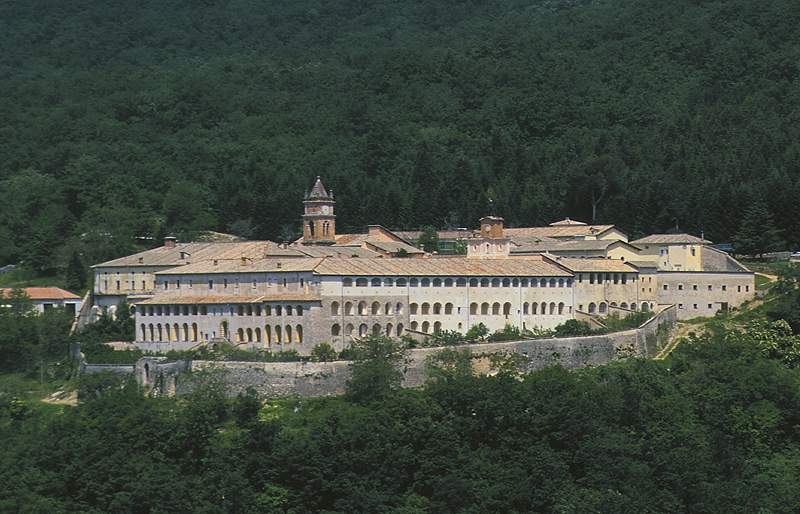After handing back the keys to the state and ousting the American ultra-right from its premises, the Certosa di Trisulti, the important thirteenth-century monastery in Collepardo (Frosinone, Italy) finally returns to open its doors to the public. The Carthusian Monastery had been given in concession in 2017 to the Dignitatis Humanae Institute (DHI) foundation, the ultra-right-wing school close to Steve Bannon, but on March 15, 2021, the Council of State ruled in favor of the Ministry of Culture that DHI did not qualify for the concession, after a two-year legal battle. So, from tomorrow, Tuesday, November 9, 2021, the public will be able to return to the Charterhouse, which has returned to the full management of the Lazio Regional Museums Directorate. The monument will once again be open to visitors thanks to the collaboration between the Ministry of Culture - Direzione Regionale Musei Lazio, the Lazio Region and the regional in-house company LAZIOcrea S.p.a.
The official announcement was made today in the Refectory of the Carthusian Monastery as part of a press conference attended by Culture Minister Dario Franceschini, Lazio Region President Nicola Zingaretti, MiC Museums General Director Massimo Osanna and Lazio Regional Museums Director Stefano Petrocchi. The Carthusian Monastery of Trisulti will count on a new tour route with free admission, which will allow the public every day to discover the history and beauty of the buildings that make up the Carthusian complex including some unseen corners of the monastery perimeter. On Saturdays, Sundays and holidays, it will also be possible to take part in free guided tours with prior reservation. New areas of the Carthusian Monastery will open to the public as soon as the work initiated in some areas of the complex by the Lazio Regional Museums Directorate is completed. With the reopening of the site on holidays, religious services in the church of St. Bartholomew will also resume, returning a place of worship so beloved by the area and the local community.
“As of today, the Charterhouse of Trisulti reopens to the public, thanks to the collaboration between the state and the region it is once again open to visitors,” Minister Franceschini stressed. “The potential of this site is incredible as fantastic are some of the places of the Charterhouse, starting with its library or pharmacy, in ancient times one of the best known in the world. Someone said ’walking is already praying.’ Visiting this place one realizes how true this is, and that is why one could imagine building around Trisulti a European meeting place of the Paths and walkers from all over Europe.”
The history of the Carthusian Monastery of Trisulti begins in the early 13th century, when Pope Innocent III assigned to Carthusian monks the primitive Benedictine abbey, a short distance from the present complex, founded by St. Dominic of Sora shortly before the year 1000. In 1204 the present Carthusian Monastery was built with the church of St. Bartholomew at its center, consecrated in 1211 and in which is preserved the lion from the original prothyrum, now placed on the cordonade in front of the so-called palace of Innocent III, in whose medieval rooms is now housed the National Library of the Carthusian Monastery.
Prominent among the buildings is the 18th-century Pharmacy, which testifies to the fact that the Certosa’s main activity until modern times was the production of medicines and liquors. In front of the entrance is the Italian garden, now restored to its original appearance, decorated with animal forms and in which medicinal herbs used for the monks’ pharmaceutical activity are stored. The interior has retained its 19th-century furnishings, display cases with apothecary jars and cabinets containing herb boxes. In the entrance hall and waiting room can be seen the fine decoration by the Neapolitan painter Filippo Balbi, with his trompe-l’oeil depictions of Benedetto Ricciardi, the monk in charge of the pharmacy around 1857, as well as precious still lifes, animals, and caricature figures of commoners, rendered with vivid realism and according to complex alchemical symbologies alluded to by numerous inscriptions with mottos.
In the large courtyard, where the 18th-century fountain dominates, can be visited the church of St. Bartholomew in which two precious wooden choirs made by Carthusian masters are preserved around the nave, the first from the mid-16th century, the second from 1688. On the walls are paintings and frescoes depicting glories of the saints including one depicting the martyrdom of the Carthusians in London, painted again by Balbi with Rubensian elegance and dramatic realism around 1863.
On the occasion of the opening to the public, visitors will be able to enter for the first time the monastery building next to the church, the large rectangular cloister and the monumental Refectory, while the small cloister with the monks’ cemetery and the chapter house decorated with wall paintings and altars made at the end of the 18th century, restored thanks to funds from the ArtBonus program and a grant made available by the Lazio Region, will soon be open to visitors.
 |
| The Charterhouse of Trisulti reopens to the public; it will be free to visit. Here's how |
Warning: the translation into English of the original Italian article was created using automatic tools. We undertake to review all articles, but we do not guarantee the total absence of inaccuracies in the translation due to the program. You can find the original by clicking on the ITA button. If you find any mistake,please contact us.